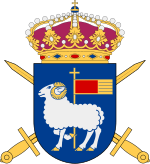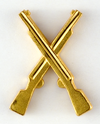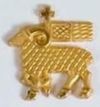Gotland Infantry Regiment
| Gotland Infantry Regiment | |
|---|---|
| Gotlands infanteriregemente | |
 | |
| Active | 1887–1963 |
| Country | |
| Allegiance | Swedish Armed Forces |
| Branch | Swedish Army |
| Type | Infantry |
| Size | Regiment |
| Part of | CO of Gotland (1867–1893) Gotland Military Area (1893–1936) Gotland's Troops (1937–1942) VII Military District (1942–1963) |
| Garrison/HQ | Visby |
| Colours | Red and white (−1953) Blue and white (1954–1963) |
| March | "In Treue Fest" (Teike)[note 1] |
| Insignia | |
| Branch insignia m/60 |  |
| Unit insignia m/60 |  |
The Gotland Infantry Regiment (Swedish: Gotlands infanteriregemente), designations I 27 and I 18, was a Swedish Army infantry regiment that traced its origins back to the 19th century. It was reorganized into an armoured regiment in 1963. The regiment's soldiers were originally recruited on the island of Gotland, and it was later garrisoned there.
History
[edit]The regiment has its origins in the unit Gotland National Conscription which was created in 1811. By a parliamentary decision in 1866 the Gotland National Conscription was transformed into an infantry regiment and an artillery corps (I 27 and A 4). A colonel was made regimental commander who also acted as the commander of Gotland's troops. The lieutenant colonel of the regiment came actually to serve as regimental commander until 1937. As of 1 January 1887 the regiment's name was Royal Gotland Infantry Regiment with the designation I 27. The regiment got a similar organization to other infantry regiments. The National Conscription's company area division remained until 1900 as the registration authority.[3]
In 1892, the agreement that Gotland's troops may not be called for military service outside the island was repealed. At the same time the name Gotland National Conscription was dropped.[3] In 1901, the army order on the mainland and Gotland became similar. This admitted, among other things, that conscripts from the mainland were transferred for training at I 27. There, at the same time, bicycle infantry training began.[4] In 1915, the regiment got Visborg Kungsladugård's land as training area and all the buildings as storehouses.[3] The bicycle infantry was developed during the World War I and the 1920s so far that I 18 (which the regiment was designated from 1928) circa 1930 became the Sweden's first bicycle regiment with motorized trains.[4]
The Defence Act of 1925 meant the end of the regiment. The regiment was downgraded to a corps which took over Västmanland Regiment designation I 18. The officers corps was reduced by 2/3. The mainland contingent of conscripts was also reduced substantially.[3] In 1936, the Royal Swedish Gotland Infantry Corps was upgraded to a regiment with the name Royal Gotland Infantry Regiment, I 18.[3] During World War II, armored units were added through the Göta Armoured Life Guards' Company in Gotland (P 1 G). Before the end of the war, this detachment was able to organize three companies (Stridsvagn m/42 and Stridsvagn m/37 and Pansarbil m/41).[4]
Through the 1949 war organization, I 18, supported by P 1 G, became responsible for an armored reinforced bicycle brigade of five battalions. The seven armored companies received via Stridsvagn m/41, Stridsvagn m/40, Infanterikanonvagn 102 finally Stridsvagn 74.[5] On 1 April 1963, the detachment was amalgamated with Gotland Infantry Regiment (I 18) and formed the Gotland Regiment (P 18) and was simultaneously transferred to the Swedish Armoured Troops.[6]
Heraldry and traditions
[edit]Coat of arms
[edit]The coat of the arms of the Gotland Infantry Regiment. It was used by Gotland Group (Gotlandsgruppen) since 2000. Blazon: "Azure, the provincial badge of Gotland, a ram passant argent, armed or, banner gules, crosstaff, edging and five flaps or. The shield surmounted two swords in saltire or".[7]
Commanding officers
[edit]Commanding officers active at the regiment the years 1884–1963. During the years 1884–1927 and 1937–1963, the commanding officer was referred to as regementschef ("regimental commander"). During the years 1928–1937 the commanding officer was referred to as kårchef ("corps commander").[8][9]
Gotland Infantry Regiment, I 27 (1887–1928)
[edit]
- 1884-04-09 – 1896-12-31: Col Herman von Hohenhausen
- 1895-07-29 – 1908-12-11: Col Gustaf Björlin
- 1908-12-18 – 1912-04-13: Col Oscar Silverstolpe
- 1912-07-02 – 1916-12-31: Col Erik Bergström
- 1917-01-01 – 1922-10-21: Col Axel Carleson
- 1922-20-22 – 1927-12-31: Col Tell Schmidt
Gotland Infantry Corps, I 18 (1928–1937)
[edit]- 1928-01-01 – 1931-11-30: Col Olof Thörnell
- 1931-12-01 – 1937-03-31: Col Gösta Törngren
Gotland Infantry Regiment, I 18 (1937–1963)
[edit]- 1937-04-01 – 1940-12-31: Col Axel Linde
- 1941-01-01 – 1942-09-30: Col Pehr Janse
- 1942-10-01 – 1945-09-30: Col Gunnar Berggren
- 1945-10-01 – 1951-09-30: Col Herman Levin
- 1951-10-01 – 1957-09-30: Col Folke Haquinius
- 1957-10-01 – 1964-03-31: Col Jan von Horn
Names, designations and locations
[edit]| Name | Translation | From | To | |
|---|---|---|---|---|
| Kungl. Gotlands infanteriregemente | Royal Gotland Infantry Regiment | 1887-01-01 | – | 1927-12-31 |
| Kungl. Gotlands infanterikår | Royal Gotland Infantry Corps | 1928-01-01 | – | 1937-06-30 |
| Kungl. Gotlands infanteriregemente | Royal Gotland Infantry Regiment | 1937-07-01 | – | 1963-03-31 |
| Designation | From | To | ||
| No. 27 | 1887-01-01 | – | 1914-09-30 | |
| I 27 | 1914-10-01 | – | 1927-12-31 | |
| I 18 | 1928-01-01 | – | 1963-03-31 | |
| Location | From | To | ||
| Visby Garrison | 1905-09-30 | – | 1963-03-31 |
See also
[edit]- List of Swedish infantry regiments
- Military on Gotland
- Gotland Brigade
- Gotland Regiment
- Gotland Artillery Regiment
Footnotes
[edit]- ^ Adopted as the Gotland Infantry Regiment's (I 18) march in 1909.[1] It was established in 1953 by Army Order 33/1953. The march was taken over by Gotland Regiment and was used by the Gotland Brigade from 1994 to 2000.[2]
References
[edit]Notes
[edit]- ^ Kjellander 2005b, p. 250
- ^ Sandberg 2007, p. 77
- ^ a b c d e National Archives
- ^ a b c Catoni 1992, p. 19
- ^ Catoni 1992, p. 20
- ^ Kjellander 2005b, pp. 115, 145
- ^ Braunstein 2006, p. 39
- ^ Kjellander 2003, pp. 263–264
- ^ Kjellander 2005b, pp. 19–25
- Braunstein, Christian (2006). Heraldiska vapen inom det svenska försvaret [Heraldry of the Swedish Armed Forces] (PDF). Skrift / Statens försvarshistoriska museer, 1101-7023 ; 9 (in Swedish). Stockholm: Statens försvarshistoriska museer. ISBN 91-971584-9-6. SELIBR 10099224. Archived from the original (PDF) on 2018-11-25. Retrieved 2018-11-28.
- Catoni, Mac, ed. (1992). Pansartrupperna 50 år 1992-10-01 (PDF) (in Swedish). [Stockholm]: [s.n.] SELIBR 9958126.
- Kjellander, Rune (2003). Sveriges regementschefer 1700-2000: chefsbiografier och förbandsöversikter (in Swedish). Stockholm: Probus. ISBN 91-87184-74-5. SELIBR 8981272.
- Kjellander, Bo, ed. (2005a). Gotlands nationalbeväring och regemente. Bd 1, Historik, befästningar, Visborgsslätt, verksamhet, regementets särart (in Swedish). Stockholm: Probus. ISBN 91-87184-79-6. SELIBR 9997590.
- Kjellander, Bo, ed. (2005b). Gotlands nationalbeväring och regemente. Bd 2, Personer och traditioner [Gotland National Conscription and regiment. Vol 2, People and traditions]. Stockholm: Probus. ISBN 91-87184-80-X. SELIBR 10002196.
- Sandberg, Bo (2007). Försvarets marscher och signaler förr och nu: marscher antagna av svenska militära förband, skolor och staber samt igenkännings-, tjänstgörings- och exercissignaler (in Swedish) (New ed.). Stockholm: Militärmusiksamfundet med Svenskt marscharkiv. ISBN 978-91-631-8699-8. SELIBR 10413065.
Web
[edit]- "Gotlands regemente" [Gotland Regiment] (in Swedish). National Archives of Sweden. Retrieved 5 April 2016.
Further reading
[edit]- Hammarhjelm, Bengt (1998). Gotländsk krigshistoria: från Gutasagan till 1814 (in Swedish). Visby: Ödin. ISBN 91-85716-81-2. SELIBR 7751979.
